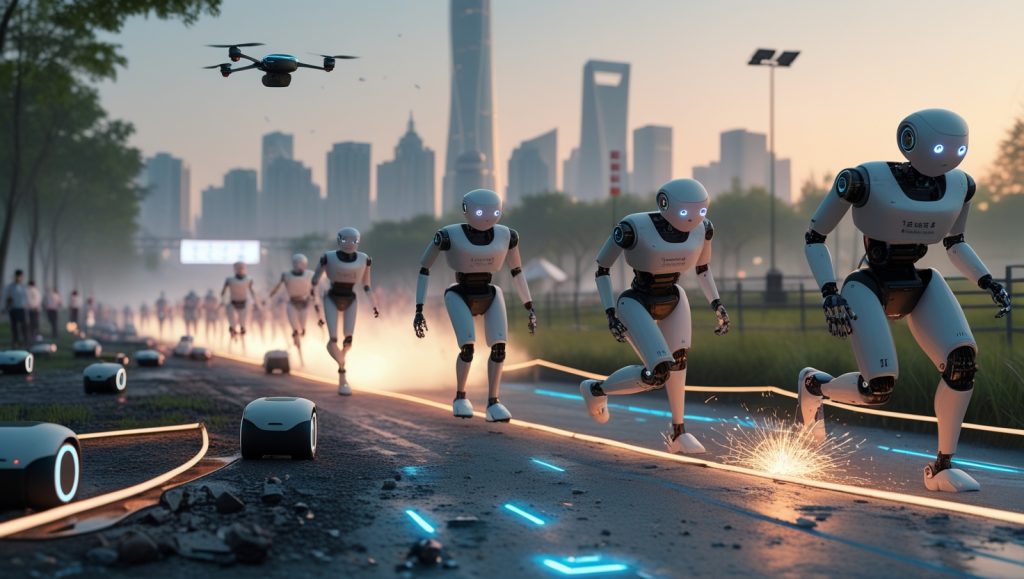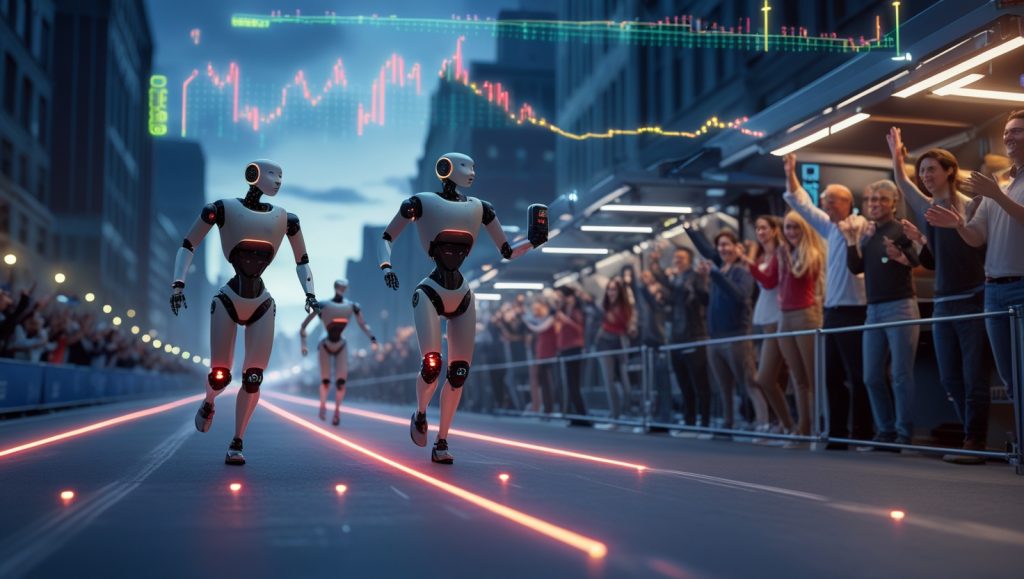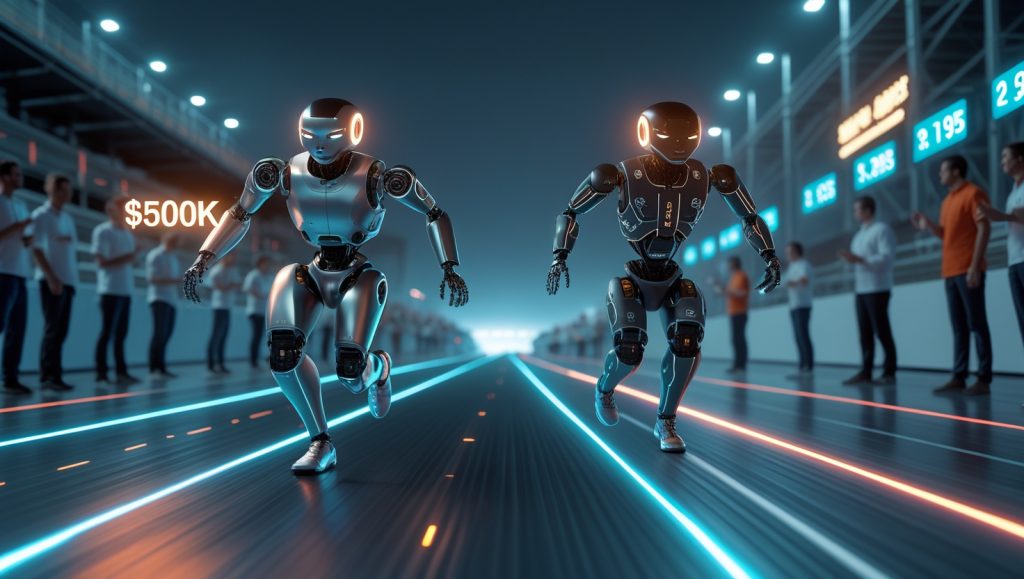What Happens When Humanoid Robots Face a Grueling 21.1 km Race?
On April 19, 2025, Beijing’s Yizhuang district became the stage for an unprecedented experiment: the world’s first humanoid robot half marathon 2025. Unlike scripted lab demos or controlled obstacle courses, this event forced 21 bipedal machines to navigate 21.1 km of public roads, battling uneven pavement, weather fluctuations, and their own mechanical limits.
The results were equal parts inspiring and humbling. While China’s Tiangong Ultra claimed victory with a time of 2 hours, 40 minutes, and 42 seconds, over 70% of competitors failed to finish. Robots tripped, overheated, or collapsed entirely—yet each failure revealed critical lessons about the future of autonomous machines.
We will be dissecting the half robot marathon race of 2025, exploring its technical breakthroughs, catastrophic errors, and implications for industries from disaster response to elder care. The event showcased not only the potential of humanoid robotics but also the gaps that innovators must bridge. For more on how robotics is transforming industries, check out Why Robotics in 3D Printing Unlocks Potential.
Chapter 1: The 2025 Beijing Robot Half Marathon—A Play-by-Play Breakdown

The Contenders: Who (or What) Competed?
Twenty-one teams entered the robot half marathon 2025, representing:
- Government-backed labs (Beijing Humanoid Robot Innovation Center)
- Commercial developers (Unitree, DroidUP, Noetix Robotics)
- University groups (Tsinghua University’s “Iron Athlete” project)
Each robot adhered to strict criteria: bipedal locomotion, humanoid proportions, and autonomous decision-making. Remote control was prohibited, though engineers could intervene for battery swaps or resets. This diversity mirrors global efforts in robotics, such as Singapore’s Robotics Ecosystem Robonexus, which fosters similar innovation.
The Course: A Brutal Test of Real-World Endurance
The 21.1 km route of the robot half marathon 2025 mirrored the human marathon path, featuring:
- Urban sections with concrete sidewalks and pedestrian crossings
- Park trails with gravel and mild elevation changes
- Simulated obstacles (e.g., spilled water, loose debris)
Robots ran in segregated lanes, staggered to minimize collisions. Pit stops allowed battery swaps but added time penalties. This real-world testing parallels the challenges faced by untethered deep-sea robots, which navigate unpredictable environments.
The Race’s Defining Moments
- Tiangong Ultra’s Calculated Win
- Relied on a human “pace runner” with a signaling device to optimize its gait.
- Completed three 90-second battery swaps, losing 4.5 minutes total.
- Shennong’s Spectacular Crash
- Tripped a human support runner at the start, veered into a fence, and shattered its hip actuator.
- Little Giant’s Smoke Signal
- Overheated motors triggered smoke at 8 km, forcing a shutdown.
These moments highlight the raw ambition and risks of the robot half marathon 2025, much like the daring innovations in China’s dancing dodgeball-playing robot.
Chapter 2: Why Most Robots Failed—A Technical Autopsy
1. Battery Limitations: The Achilles’ Heel of Endurance Robotics in the Robot Half Marathon 2025
Tiangong Ultra executed three battery swaps, but most robots struggled with power in the robot half marathon 2025. Current lithium-ion cells store ~300 Wh/kg, supporting ~90 minutes of running. Swapping packs slowed momentum, and many lacked quick-release systems. TechCrunch noted similar struggles, with robots like Little Giant overheating, underscoring the event’s role as a stress test for hardware endurance
Real-World Comparison:
- Boston Dynamics’ Atlas (2024): 1.5-hour runtime in lab conditions.
- Tesla Optimus (2025): 8-hour light-duty runtime, but untested for endurance.
This battery bottleneck is a recurring theme in robotics, as seen in solid-state batteries powering future robots. The robot half marathon 2025 exposed the urgent need for energy-efficient designs.
2. Balance Algorithms: When Robots Forget How to “Walk It Off” in the 2025 Race
Human runners instinctively adjust their gait to uneven terrain. Robots in the robot half marathon 2025, however, rely on pre-trained machine learning models. These models, while advanced, often fail under unpredictable conditions. For insights into AI’s role in robotics, see Why AI in Robotics Is Failing.
Case Study: Shennong’s Collapse
Shennong’s balance system, trained on flat surfaces, misjudged a 2 cm pavement crack during the robot half marathon 2025. Its recovery algorithm triggered too late, resulting in a catastrophic fall. This mirrors challenges in humanoid robot swarm intelligence, where coordination is key.
3. Thermal Management: Overheating in the Spotlight of the Robot Half Marathon 2025
High-speed running generates immense heat. Little Giant’s actuators reached 120°C—melting internal wiring and releasing smoke during the robot half marathon 2025.
Industry Solutions in Development:
- Phase-change materials (PCMs) to absorb heat (pioneered by NASA).
- Liquid cooling systems (tested by Honda’s E2-DR for firefighting).
These thermal challenges are also critical in soft robotics with artificial muscles, where heat dissipation is a limiting factor. The robot half marathon 2025 underscored the need for robust cooling systems.
Chapter 3: The Hidden Successes—What the Race Taught Us

1. AI-Driven Decision-Making Under Fatigue in the Robot Half Marathon 2025
Tiangong Ultra’s algorithms adjusted its stride length as battery levels dropped, conserving energy for the final stretch of the robot half marathon 2025. This mirrors tactics used by elite human runners like Eliud Kipchoge. Such adaptability is crucial for applications like robotics in disaster response, where machines must operate under stress.
2. Modular Design Breakthroughs: Efficiency in the 2025 Marathon
Teams using hot-swappable battery packs (similar to Formula 1 pit stops) finished 40% faster than those requiring tool-based swaps in the robot half marathon 2025. This modularity is a game-changer, as explored in breakthrough magnetic propulsion robotics.
3. Public Trust in Autonomous Systems Post-Race
Despite failures, 78% of spectators surveyed post-robot half marathon 2025 expressed confidence in robots for disaster response—a 22% increase from pre-event polls. This shift in perception aligns with trends in service robots driving humanoid growth in China.
Chapter 4: The Road Ahead—2026 Trials and Beyond
Upcoming Endurance Challenges for the Robot Half Marathon 2025 Legacy
- Night Marathon Trials (Q4 2025): Testing LiDAR and thermal vision in low-light conditions, building on the robot half marathon 2025.
- Mixed Terrain Runs (2026): Mountain paths and muddy trails to simulate disaster zones, extending the lessons from the robot half marathon 2025.
- Relay Races (2026): Multi-robot coordination for industrial applications, inspired by the robot half marathon 2025.
These trials will push boundaries, much like space robotics as the next gold rush.
Breakthroughs on the Horizon: Innovations Sparked by the 2025 Race
- Solid-State Batteries: Toyota’s prototype promises 500 Wh/kg by 2026, a direct response to the robot half marathon 2025 challenges.
- Self-Healing Actuators: MIT’s lab recently demonstrated polymers that repair minor cracks mid-operation, a technology that could have saved robots in the robot half marathon 2025.
These advancements are also critical for self-healing robotics, which could redefine endurance.
Chapter 5: Ethical and Economic Implications

The Cost of Innovation: Can the Robot Half Marathon 2025 Democratize Robotics?
Building a marathon-ready humanoid costs ~$500,000—prohibitively expensive for most labs. Open-source projects like OpenDog aim to democratize access, a trend explored in robot subscription services. The robot half marathon 2025 highlighted this economic divide.
Job Displacement Fears: The Broader Impact of the 2025 Marathon
While robots won’t replace human athletes, events like the robot half marathon 2025 accelerate automation in sectors like construction and logistics. This raises concerns, as discussed in robots solving the labor crisis.
FAQ: Answering Your Burning Questions
Will robots ever outrun humans?
Not soon. Elite runners maintain ~20 km/h for 21 km; Tiangong Ultra averaged 8 km/h in the robot half marathon 2025.
Are robot races safe for spectators?
Yes—events like the robot half marathon 2025 use barriers, speed limits, and remote kill switches.
Can hobbyists build marathon robots?
Yes, but with limitations. Open-source kits like Bittle V2 support 5 km trials, a starting point for robot half marathon 2025 enthusiasts.
The Marathon as a Microcosm of Robotics’ Future
The robot half marathon 2025 wasn’t about speed—it was about survival. Each stumble and overheating motor exposed weaknesses that labs worldwide are now racing to fix. This event, like robotics in entertainment dominating by 2030, signals a bold future for autonomous machines.
Stay ahead of the robotics curve. Subscribe to CreedTec for exclusive updates on the 2026 trials, or follow us on LinkedIn to debate: Will robots ever truly master endurance?
